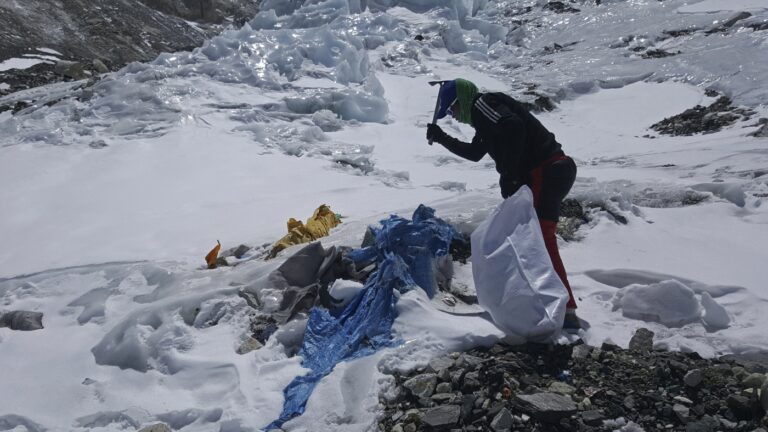A member of a Nepalese government-funded team uses a shovel to remove frozen debris on Mount Everest in Nepal in 2021. In the seven decades since Mount Everest was first conquered, thousands of climbers have scaled the peak, and many have left behind more than just their footprints.
Peak Promotion/AP
hide legend
toggle caption
Peak Promotion/AP
KATHMANDU, Nepal — The highest camp on the world’s highest mountain is littered with trash that will take years to clean up, according to a Sherpa who led a team cleaning up trash and digging up bodies that had been frozen for years near the summit of Mount Everest.
The Nepalese government-funded team of soldiers and Sherpas removed 11 tonnes of rubbish, four dead bodies and a skeleton from Everest during this year’s climbing season.
Ang Babu Sherpa, who led the Sherpa team, said there could be as much as 40 to 50 tons (88,000 to 110,000 pounds) of trash still at the South Col, the last camp before climbers attempt the summit.
“The waste left there was mainly old tents, food packaging and gas cartridges, oxygen cylinders, tent bags and ropes used for climbing and tying tents,” he said, adding that the waste is layered and frozen at the 8,000-metre (26,400-foot) altitude where the South Col camp is located.
Since the peak was first conquered in 1953, thousands of climbers have scaled it and many have left behind more than just their footprints.
In recent years, the requirement for climbers to bring back their waste or lose their deposit, as well as increased environmental awareness among climbers, has significantly reduced the amount of waste left behind. However, this was not the case in previous decades.
“Most of the waste comes from old expeditions,” Ang Babu says.
The team’s Sherpas collected trash and bodies from high-altitude areas, while the soldiers worked at lower levels and in the base camp area for weeks during the popular spring climbing season, when weather conditions are more favorable.

Garbage collected en route to Mount Everest is stacked before being sorted for recycling at a facility operated by Agni Ventures, an agency that manages recyclable waste, in Kathmandu, Nepal, Monday, June 24, 2024.
Sanjog Manandhar/AP
hide legend
toggle caption
Sanjog Manandhar/AP
Ang Babu said the weather poses a major challenge to their work in the South Col region, where oxygen levels are about a third of normal, winds can quickly turn into blizzard conditions and temperatures plummet.
“We had to wait for the sun to melt the ice layer. But waiting for a long time in these conditions is not possible,” he explained. “It is difficult to stay for a long time with a very low oxygen level.”
Digging up the waste is also a difficult task, as it is frozen in ice and breaking the blocks is not easy.
It took two days to exhume a body near the South Col, which had been frozen upright in the ice, he said. Halfway through, the team had to retreat to lower camps because of worsening weather conditions, then resume work once conditions improved.

Another body was much higher, at 8,400 meters (27,720 feet), and it took 18 hours to drag it to Camp 2, where a helicopter recovered it.
The bodies were flown to Tribhuvan University Hospital in Kathmandu for identification.
Of the 11 tonnes of waste removed, three tonnes of decomposable waste were transported to villages near the base of Everest and the remaining eight tonnes were carried by porters and yaks and then trucked to Kathmandu. They were sorted for recycling at a facility run by Agni Ventures, an agency that manages recyclable waste.
“The oldest waste we received was from 1957, and it was rechargeable batteries for flashlights,” said Sushil Khadga of the agency.
Why do climbers leave trash behind?
“At this altitude, life is very difficult and oxygen is very low, so climbers and their assistants are more focused on their own survival,” Khadga said.


